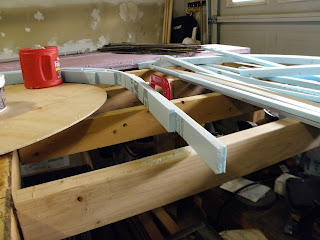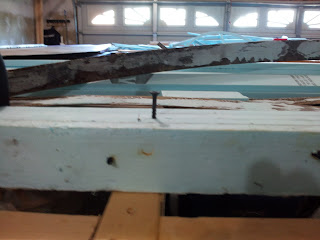When I'm waiting on folks I try to keep busy, but sometimes I don't want to start a big project because they might come along any minute. To bide some time I decided to make some of those PVC supports I told you about in the last entry.
I need to make some corrections on my "bill of materials". The smaller PVC pipe, the upright, is 1/2" I.D but it's PVC-1120 SDR21 not SCH40. The PVC-1120 SDR21 is thin walled as compared to the thicker walls of Schedule 40. Same with bigger pipe, the "socket" is actually 3/4" I.D. The shelf in the store said 1". Sorry about that...
 |
| Revised Smokejack Roadbed Support |
I gang drilled both the socket and upright parts from 10' lengths of the respective pipe. I started with the sockets and laid out the 1/2" diameter holes first...
 |
| Center Markings for 1/2" Dia Holes |
I used a brad point bit to drill a hole at each location. Brad points don't really need a pilot hole, the small point can be aligned to the center markings. I was careful to use a lower drill speed. Too fast and I could lose control resulting in torn pipe and/or hand...
After all the holes were drilled I used a pull saw to cut the sockets apart...
 |
| !/2" Holes Drilled Before Cutting. |
After all the holes were drilled I used a pull saw to cut the sockets apart...
 |
| Sockets Cut to Length |
Once the I had cut the 10' length of 3/4" I.D. into sockets, I started on the 1/2" I.D. uprights. As before I laid out the center locations along the stencil on the side of the pipe. I then drilled a pilot hole at every other line. I wanted to cut a 10" section of pipe with the hole saw. I took my time lining up the hole saw, making sure the saw was centered on the pipe. Once all the holes were made I cut each 10" length in two, creating the 5" long upright...
 |
| Hole Saw Cuts Every 10" |
 |
| 10" Section Ready to be Cut in Two |
I had quite a bit of 1/2" schedule 40 PVC laying about from the helix. Some of it was already cut to 2", just perfect for the 2 track roadbed. I cut some 4" lengths from a 5' section I had on hand. I then glued these crosspieces to the curved notch in the upright and set them aside to dry......
 |
| Uprights for 2 Track Roadbed |
 |
| Uprights for 4 Track Roadbed |
 |
| Assembled Smokejack |
The folks I was waiting on finally showed up. They're here to cut down what's left of that cedar tree the tornado chewed back in January. I'll be so glad to see that @#$% thing gone!
In the next installment, I'll glue up the unfinished roadbed. The supports go in once that's done and the glue sets. Then I adjust the grade and start laying ballast strip and track.
Regards
Frank Musick
Chief Cook and Bottle Washer
 |
| Allegheny Eastern Railroad |





































